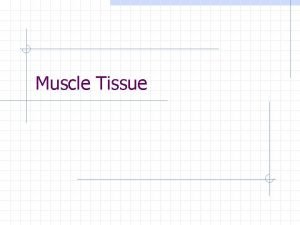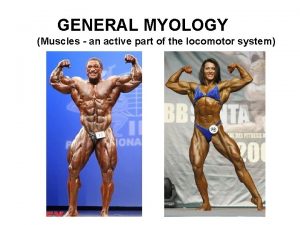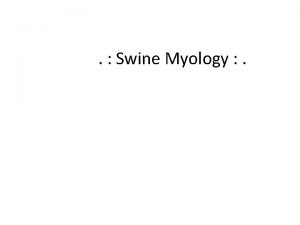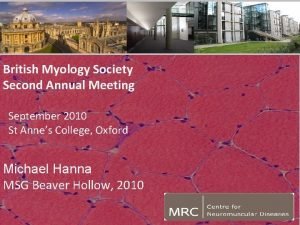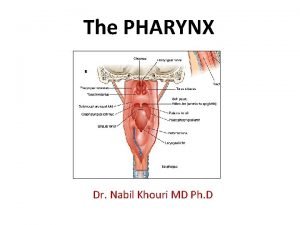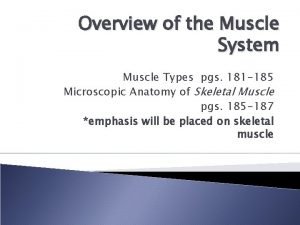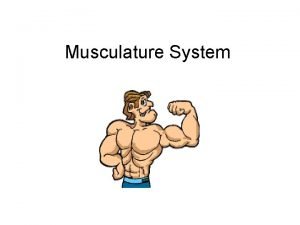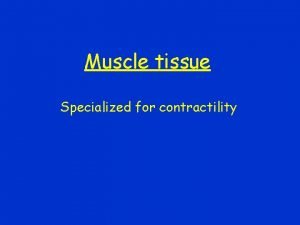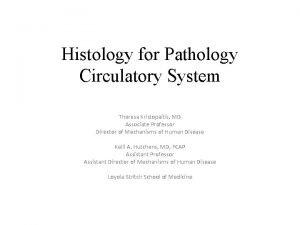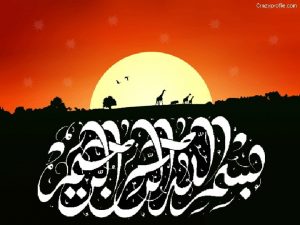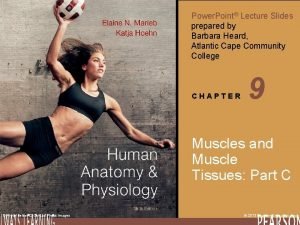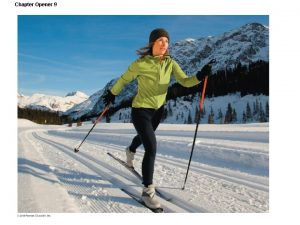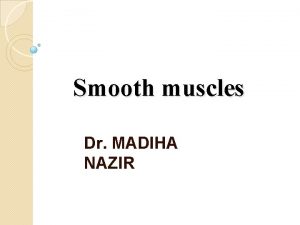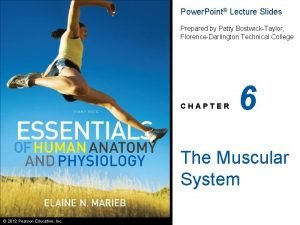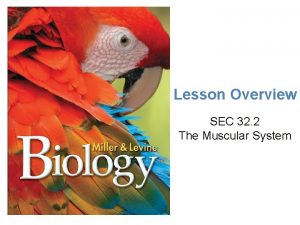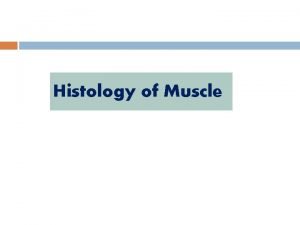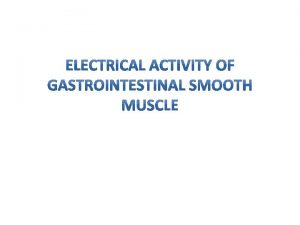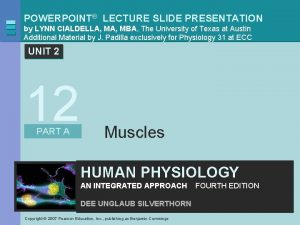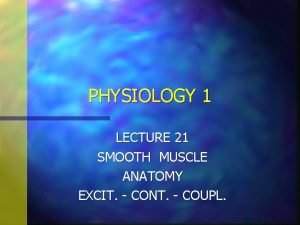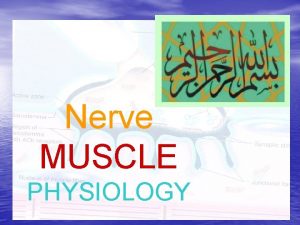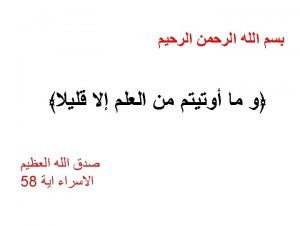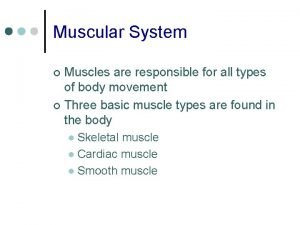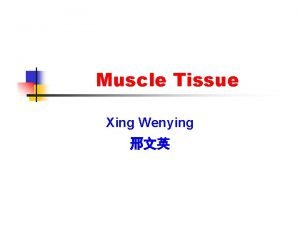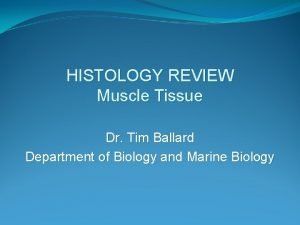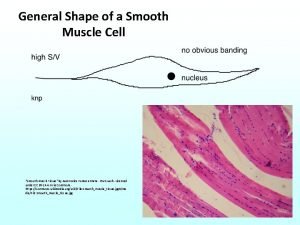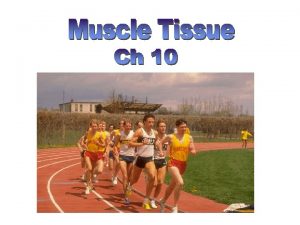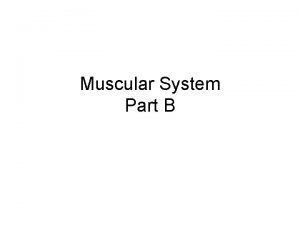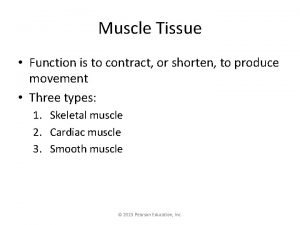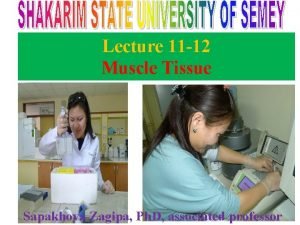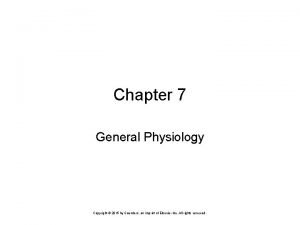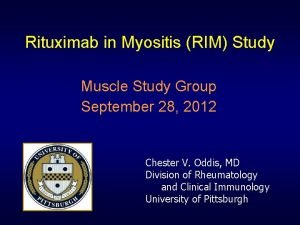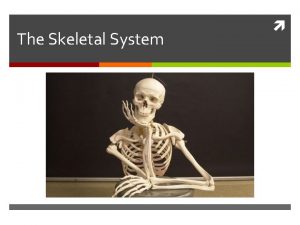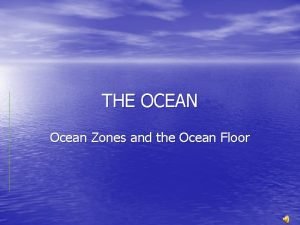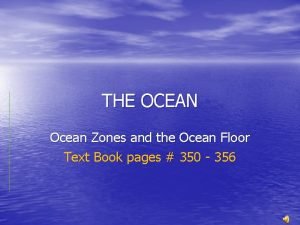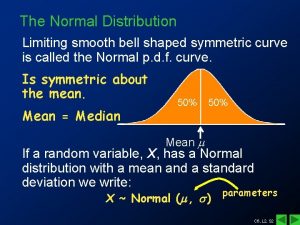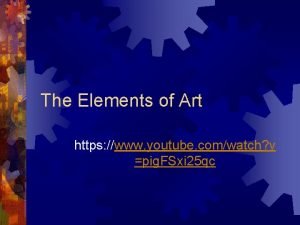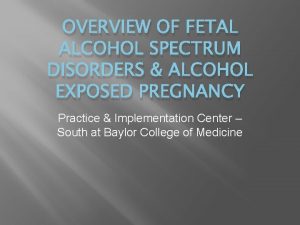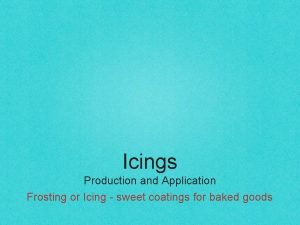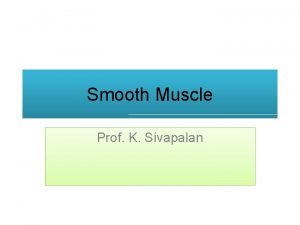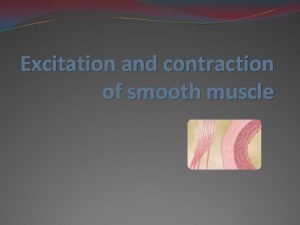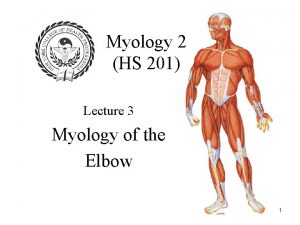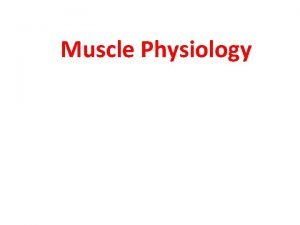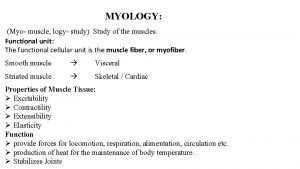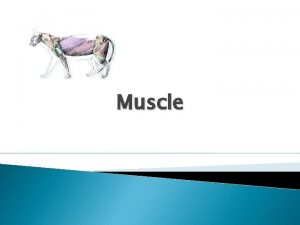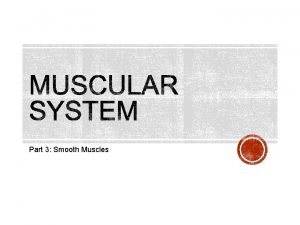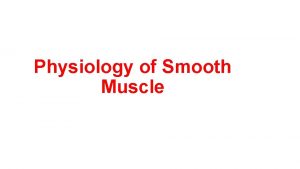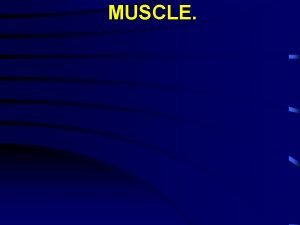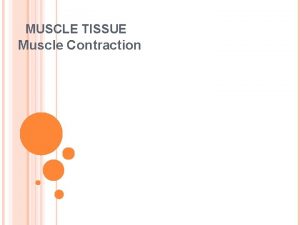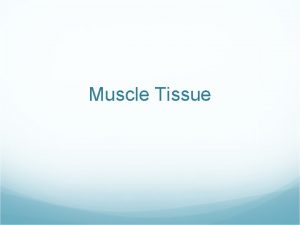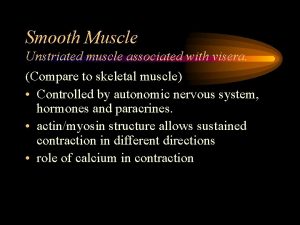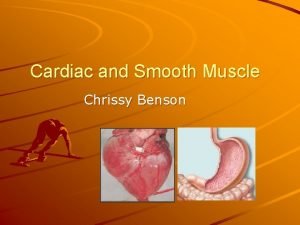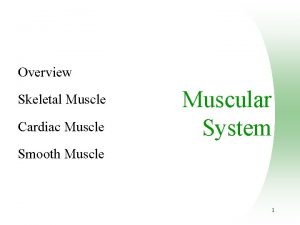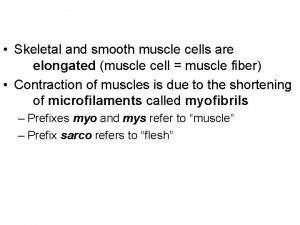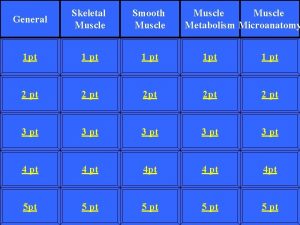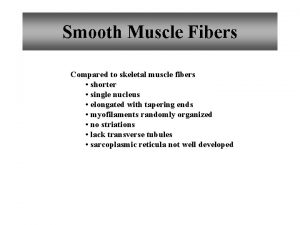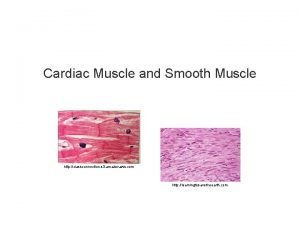Muscle myology the study of muscle Types Smooth





















































































- Slides: 85

Muscle (myology - the study of muscle)

Types – Smooth, skeletal, cardiac

Functions – Motion within Regulate organ volume https: //www. youtube. com/watch? v=Ujr 0 UAby. PS 4

Movement Stabilized position Heat Production https: //www. youtube. com/watch? v=6 Ob. Nn. CTV 6 MY


Characteristics Excitability - able to receive/respond to stimuli Contractibility - the ability to shorten

Characteristics Excitability - able to receive/respond to stimuli Contractibility - the ability to shorten https: //www. youtube. com/watch? v=p. WAvm. QZjd. Xk Extensibility - the ability to lengthen Elasticity - the ability to return to original size


Skeletal Muscle Connective tissue 1. Fascia (fibrous connective tissue under skin or around organs) superficial / under skin deep -- endomysium (fascia around a single muscle fiber) perimysium (fascia around a bunch of muscle fibers) epimysium (fascia around the entire muscle)



Muscle structure 1. Muscle → bundle of muscle fibers (fascicle) → muscle fiber -- (single cell covered by a sarcolemma - plasma membrane / filled with sarcoplasm – cytoplasm / has lots of mitochondria for ATP) → myofibrils made of sarcomere sections which have a thick filament (w/ the protein myosin and its crossbridges) and a thin filament (w/ actin, troponin and tropomyosin)

Muscle structure 1. Muscle → bundle of muscle fibers (fascicle) → muscle fiber -- (single cell covered by a sarcolemma - plasma membrane / filled with sarcoplasm – cytoplasm / has lots of mitochondria for ATP) → myofibrils made of sarcomere sections which have a thick filament (w/ the protein myosin and its crossbridges) and a thin filament (w/ actin, troponin and tropomyosin)




2. A myofibril does not run the entire length of the muscle fiber. They run parallel to each other to run the length of the cell. This increases the effect of their contraction.

https: //www. youtube. com/watch? v=ousflr. Oz. QHc 4: 24 https: //www. youtube. com/watch? v=BVcg. O 4 p 88 AA&vl=en 2: 48 https: //www. youtube. com/watch? v=Gneon. Flc. ZG 8 6: 17

Muscle Types

https: //www. youtube. com/watch? v=b. Mq. S 9 ad-1 x. M Start at 133

Thoroughbreds have an average of 80 to 90% fast-twitch muscle fibers, while Arabian and Standardbred horses are close to this level with about 75% fast-twitch fibers


https: //www. photo. lynnesite. com/Clients/Event. Archive/Coso. Junction-2015 -2016 -Season/i-7 JH 3 CQ 9/A


Muscular contraction and nervous impulses A. Events 1. The sequence of events that result in the contraction of an individual muscle fiber begins with a signal— the neurotransmitter, ACh—from the motor neuron innervating that fiber. The local membrane of the fiber will depolarize as positively charged sodium ions (Na+) enter, triggering an action potential that spreads to the rest of the membrane.


2. This triggers the release of calcium ions (Ca++) from storage in the sarcoplasmic reticulum (SR).

3. The Ca++ then binds to the troponin to initiates contraction, which is sustained by ATP. The binding of the Ca++ unshields the actin binding sites from the myosin. When the actin binding sites are uncovered, the myosin crossbridges are free to bind and, with the help of ATP, move the actin filament.




4. One movement is called a power stroke.

5. As long as Ca++ ions remain in the sarcoplasm to bind to troponin, which keeps the actin-binding sites “unshielded, ” and as long as ATP is available to drive the cross-bridge cycling and the pulling of actin strands by myosin, the muscle fiber will continue to shorten to an anatomical limit. https: //www. youtube. com/ watch? v=U 2 TSaz 8 -y. NQ

6. Muscle contraction usually stops when signaling from the motor neuron ends, which repolarizes the sarcolemma and T-tubules, and closes the voltage-gated calcium channels in the SR. Ca++ ions are then pumped back, using ATP, into the SR, which causes the tropomyosin to reshield (or re-cover) the binding sites on the actin strands.

7. A muscle also can stop contracting when it runs out of ATP and becomes fatigued

B. Rigor mortis results when death leads to a leaking out of the Ca+2 ions from the sarcoplasmic reticulum into the sarcoplasm of the muscle cell. This causes the troponin to uncover the myosin binding sites and a power stroke to occur. However, since the person is dead, there is no ATP available to detach the myosin cross bridges. This leads to a sustained contraction - stiff

C. Energy 1. ATP - there is enough stored for 5 seconds of contraction 2. Creatine phosphate - there is enough stored for 15 seconds of contraction


3. Anaerobic respiration (glycolysis) - the breakdown of stored glucose stored as glycogen, to create pyruvic acid and ATP - enough energy for 30 seconds 4. Aerobic respiration uses pyruvic acid and oxygen to create ATP. This can provide energy as long as oxygen and nutrients last. Aerobic is the muscle's preferred choice since it can last the longest



D. All or none principle 1. In order to contract, muscles need a certain level of stimulus, the threshold, from a nerve. If the impulses is not up to the level, the muscle will not contract at all.

2. Muscle fibers do not partially contract. If there is a weak muscular action, it is not because the fibers contracted weakly. Muscles fibers always contract to their full ability. A weak muscle action is because only a few muscle fibers contracted. It’s a number thing.

E. Homeostasis 1. Oxygen debt – the amount of oxygen necessary to return body systems to normal after heavy exercise. Lactic acid accumulation in muscle tissue causes the hard breathing needed to pay the debt

2. Muscle fatigue - the inability of a muscle to sustain its contractile strength. Sustained contraction leads to a body depletion of oxygen and glycogen. The inability of muscle to “go on" causes them to stop, so that oxygen and glycogen levels can be returned to normal.

3. Heat - 85% of the energy in muscles can be released as heat to cool the body. When the body is cold, shivering will generate heat to warm it back up

F. Contraction types - depends of stimulation frequency

1. Twitch - a brief contraction of all fibers in a motor unit from a single action potential - Latent period - Contraction period - Relaxation period - Refractory period


2. Tetanus - a sustained contraction or short relaxation period. Comes from multiple action potentials arriving near the end of, or after the refractory period. Most voluntary movements are of this type

3. Isotonic – when a muscle contracts and pulls on another structure to create motion 4. Isometric - when a muscle contracts and pulls on another structure, but no motion occurs. EX - Pushing with all your strength against a building

G. Muscle tone 1. A sustained partial contraction, no motion. Some, but not many, muscle fibers are contracting at a time. EX - posture

H. Abnormalities 1. Hypotonia - decreased muscle tone, flaccid 2. Hypertonia - increased muscle tone, rigid


I. Muscular size 1. Muscular atrophy - wasting away of muscle tissue. Caused by inactivity. Complete atrophy can be caused by a loss of the nerve supply to the muscle. This will cause atrophy and the muscle tissue will be replaced by fibrous tissue. This is an irreplaceable loss

2. Muscular hypertrophy - increase in muscle size due to an increase in use. Muscles do not increase in number after birth. Therefore Pee Wee Herman can NEVER get as muscular as Mr. Universe no matter how much he lifts weights. Conversely, Mr Universe could never become Pee Wee Herman size, since he has more muscle fibers.

Cardiac Muscle A. Characteristics 1. Involuntary 2. Branching 3. Striated striped 4. Shorter, thicker, more square shaped than skeletal


B. Arrangement 1. The atria have one network (a branching and interconnection of muscle fibers), while the ventricles have a 2 nd. 2. Fibers within a network are connected by intercalated discs which have a gap junction to speed along impulses.

C. Differences 1. Cardiac tissue beats continuously, we hope, so needs a constant energy supply

C. Differences 1. Cardiac tissue beats continuously, we hope, so needs a constant energy supply 2. Cardiac tissue causes its own contractions, its own nervous impulses, in the pacemaker. This is called autorhythmicity.



3. Cardiac tissue has a long refractory period. This reduces the possibility of tetanus - a stopped, contracted heart.



Smooth Muscle A. Characteristics 1. Involuntary 2. Found in organs 4. Flexible 3. Not striped


B. Types 1. Visceral a. Large sheets that form a continuous network of muscle b. The whole sheet responds to a single impulse, not singly like https: //www. youtube. com/watch? v=o 18 Uyc. WRsa. A skeletal muscle

c. Found in small blood vessels, stomach, intestines, uterus, bladder. d. More common type of smooth muscle

2. Multiunit smooth muscle a. Acts like skeletal with individual fibers contracting individually. b. Found in large blood vessels, large lung airways, arrector pili muscles (hair) https: //www. youtube. com/wa tch? v=Ek. ZTxbn. ALo. E



C. Differences 1. Longer contractile periods than skeletal 2. Can sustain a contraction longer = more tone

C. Differences 1. Longer contractile periods than skeletal 2. Can sustain a contraction longer = more tone 3. Can be stimulated by nervous impulses, hormones, p. H, gas levels, temperature. 4. More extensible

How Movement is Produced A. Origin and insertion 1. Skeletal muscles pull on bones through tendons. Muscles are attached at both ends to bone. The tendon attached to the stationary bone is called the origin. The other tendon, attached to the moving bone, is called the insertion. 2. The middle part of the muscle is called the belly.


B. Actions 1. Antagonistic – muscles are paired in an antagonistic relationship. EX. Biceps pull the forearm up and triceps pull it back.


2. Types a. Agonist – the primary muscle causing the action – bicep flexing the elbow b. Antagonist – relaxed during the motion of the agonist, but contracts to return the moved part to its original position – tricep extending out the elbow.


c. Synergist – assists the agonist – the anconeus muscle helps the bicep d. Fixators – stabilizes the agonist - the rotator cuff muscles stabilize the bicep’s motion

Naming Skeletal Muscles Muscle can be named using a variety of parameters.


 Study of myology
Study of myology Smooth muslce
Smooth muslce Division of muscles
Division of muscles General myology
General myology Muscle
Muscle British myology society
British myology society Oropharyngeal isthmus
Oropharyngeal isthmus Comparison of skeletal cardiac and smooth muscle
Comparison of skeletal cardiac and smooth muscle Smooth muscle under the microscope
Smooth muscle under the microscope Nucleus of smooth muscle fiber in cross-section
Nucleus of smooth muscle fiber in cross-section Characteristics of skeletal smooth and cardiac muscle
Characteristics of skeletal smooth and cardiac muscle Large artery histology
Large artery histology Tetany vs tetanus
Tetany vs tetanus Slide
Slide Comparison of skeletal cardiac and smooth muscle
Comparison of skeletal cardiac and smooth muscle Varicosities of smooth muscle
Varicosities of smooth muscle Characteristics of skeletal smooth and cardiac muscle
Characteristics of skeletal smooth and cardiac muscle Purpose of smooth muscle
Purpose of smooth muscle Cardiac muscle tissue
Cardiac muscle tissue Smooth muscle
Smooth muscle Smooth muscle
Smooth muscle Muscle stimulation
Muscle stimulation Smooth muscle myosin
Smooth muscle myosin Smooth muscle
Smooth muscle Inferior oblique
Inferior oblique L
L Muscle histology review
Muscle histology review Dag protein kinase c
Dag protein kinase c Type of tissue
Type of tissue Isotonic exercise
Isotonic exercise Cardiac muscle tissue labeled
Cardiac muscle tissue labeled Filament bending
Filament bending Nervous tissue function
Nervous tissue function Function of smooth muscle
Function of smooth muscle Which muscle is striated in appearance but resembles smooth
Which muscle is striated in appearance but resembles smooth Toe dancers muscle a two bellied muscle of the calf
Toe dancers muscle a two bellied muscle of the calf Hình ảnh bộ gõ cơ thể búng tay
Hình ảnh bộ gõ cơ thể búng tay Ng-html
Ng-html Bổ thể
Bổ thể Tỉ lệ cơ thể trẻ em
Tỉ lệ cơ thể trẻ em Gấu đi như thế nào
Gấu đi như thế nào Chụp tư thế worms-breton
Chụp tư thế worms-breton Chúa sống lại
Chúa sống lại Môn thể thao bắt đầu bằng chữ f
Môn thể thao bắt đầu bằng chữ f Thế nào là hệ số cao nhất
Thế nào là hệ số cao nhất Các châu lục và đại dương trên thế giới
Các châu lục và đại dương trên thế giới Công thức tiính động năng
Công thức tiính động năng Trời xanh đây là của chúng ta thể thơ
Trời xanh đây là của chúng ta thể thơ Mật thư tọa độ 5x5
Mật thư tọa độ 5x5 Làm thế nào để 102-1=99
Làm thế nào để 102-1=99 Phản ứng thế ankan
Phản ứng thế ankan Các châu lục và đại dương trên thế giới
Các châu lục và đại dương trên thế giới Thể thơ truyền thống
Thể thơ truyền thống Quá trình desamine hóa có thể tạo ra
Quá trình desamine hóa có thể tạo ra Một số thể thơ truyền thống
Một số thể thơ truyền thống Cái miệng nó xinh thế
Cái miệng nó xinh thế Vẽ hình chiếu vuông góc của vật thể sau
Vẽ hình chiếu vuông góc của vật thể sau Thế nào là sự mỏi cơ
Thế nào là sự mỏi cơ đặc điểm cơ thể của người tối cổ
đặc điểm cơ thể của người tối cổ V. c c
V. c c Vẽ hình chiếu đứng bằng cạnh của vật thể
Vẽ hình chiếu đứng bằng cạnh của vật thể Fecboak
Fecboak Thẻ vin
Thẻ vin đại từ thay thế
đại từ thay thế điện thế nghỉ
điện thế nghỉ Tư thế ngồi viết
Tư thế ngồi viết Diễn thế sinh thái là
Diễn thế sinh thái là Dot
Dot Số nguyên là gì
Số nguyên là gì Tư thế ngồi viết
Tư thế ngồi viết Lời thề hippocrates
Lời thề hippocrates Thiếu nhi thế giới liên hoan
Thiếu nhi thế giới liên hoan ưu thế lai là gì
ưu thế lai là gì Hươu thường đẻ mỗi lứa mấy con
Hươu thường đẻ mỗi lứa mấy con Khi nào hổ mẹ dạy hổ con săn mồi
Khi nào hổ mẹ dạy hổ con săn mồi Hệ hô hấp
Hệ hô hấp Từ ngữ thể hiện lòng nhân hậu
Từ ngữ thể hiện lòng nhân hậu Thế nào là mạng điện lắp đặt kiểu nổi
Thế nào là mạng điện lắp đặt kiểu nổi Manual muscle test score
Manual muscle test score Bone markings
Bone markings The deep ocean floor that is nearly flat
The deep ocean floor that is nearly flat Smooth nearly flat region of the ocean floor
Smooth nearly flat region of the ocean floor The normal curve is smooth and symmetric.
The normal curve is smooth and symmetric. Shapes that have more complicated edges
Shapes that have more complicated edges Palpebral fissure
Palpebral fissure Foam type icing
Foam type icing
